The Blade Runner FAQ
Miscellaneous Movie questions
| What is BR? |
| News & Views |
| The FAQ |
| Encyclopedia |
| Quotes |
| People |
| Locations |
| Scripts |
| Analysis |
| Fan-tastic |
| BR Fun |
| BR Game |
| BR Magazine |
| BR Comic |
| Downloads |
| Collectibles |
| Related |
| Links |
| Site Info |
| Search Site |
BRmovie.com is the Home of Blade Runner - the current Blade Runner FAQ, news, resources, links, quotes, scripts and everything else Blade Runner.

![]()
Blade Runner
Buy this Mini Poster at AllPosters.com
|
Any
Comments? Please e-mail the Webmaster |
| Want the DVD? Or the BR Game? Don't know which books or music to get? Maybe you'd like a Deckard action figure? Make sure you check the BR Related section for all your BR choices. |
In the beginning of the movie we see these big fireballs. What are they?
The flares are known as "sour gas". From: "The Disposal of Sour Gas through Flaring by Oil Companies" "Sour gas is any gas in its natural state that contains impurities which form acidic combustion products. Sour gas also contains compounds of sulfur at concentrations exceeding levels for practical use because of their corrosion and toxicity. Sour gas contains over 250 different compounds, some of which are carbon dioxide, methyl mercaptan and hydrogen sulphide..." "Flaring is a means of safely disposing of waste gases through
the use of combustion. With an elevated flare the combustion is
carried out at the top of a pipe or stack where the burner and igniter
are located." Whose eye is that in the beginning?
Note: because of the level of the windows, the character wouldn't in fact be able to actually see the cityscape, even though this seems to be the intention… Does Holden survive being shot by Leon Kowalski?
(A movie clip of some of the deleted hospital scene is available for download from BRmovie.com)
|
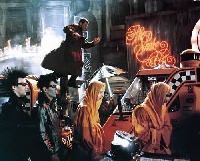 |
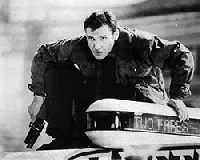 |
The extended chase over the car rooftops was shot, but never included in any released version of the film, either theatrically or on home video. However, there are a few still photos from this deleted sequence which have been used repeatedly in promoting the film, so that's probably where you saw it.
Which companies were featured in BR?
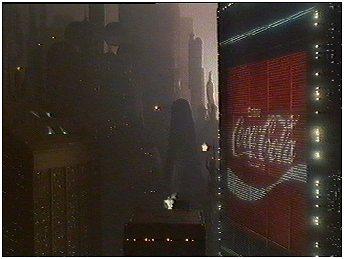
ANACO, Atari, Atriton, Bell, Budweiser, Bulova, Citizen, Coca-Cola, Cuisine Art, Dentyne, Hilton, Jovan, JVC, Koss, L.A. Eyeworks, Lark, Marlboro, Million Dollar Discount, Mon Hart, Pan Am, Polaroid, RCA, Remy, Schiltz, Shakey's, Toshiba, Star Jewelers, TDK, The Million Dollar Movie, TWA, Wakamoto.
Why is there talk of a BR curse?
Someone once noticed that a number of the companies whose logos appeared in BR had financial difficulties after the film was released. Atari had 70% of the home console market in 1982, but faced losses of over $2 million in the first quarter of 1991. Bell lost it's monopoly in 1982. Pan-Am filed for bankruptcy protection in 1991. Soon after Blade Runner was released, Coca-Cola released their "new formula", resulting in losses of millions of dollars. (It is interesting to note that since then, the Coca-Cola Company has seen the biggest growth of any American company in history.) Cuisine Art filed for bankruptcy protection in July 1989.
Then again, it should also be noted that a lot of companies NOT featured in BR went bust too. It's a fact of life, if you will; either they go bankrupt, or they merge with another company, or just change names, etc.
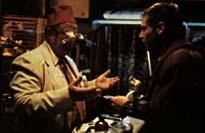 Who
is the actor who plays Abdul-Ben Hassan, the snake dealer?
Who
is the actor who plays Abdul-Ben Hassan, the snake dealer?
No one seems to know! It's a mystery! He is not mentioned anywhere
in the credits... Even Future Noir does not have any information
regarding the man's real-life identity. He's not in any other FAQ.
And, yes, we did check the IMDb.
When Abdul and Deckard are arguing, why don't the words match the lip movements?
In Future Noir, Terry Rawlings is quoted, "The reason that changed between the workprint and release print was because certain producers felt the original dialogue exchange was confusing. The higher-ups wanted to clarify things and give the audience more of an explanation about what Deckard was after and what this snake scale meant. So new words were looped in during postproduction. That didn't really work, though, did it?"
The original words are:
Deckard: Abdul Hassan? I'm a police
officer, Abdul. I've got a couple of questions I wanted to ask you.
Abdul: (speaks in his native tongue,
waves his arms)
Deckard: You made a snake, XB7 1. I
want to know who you sold it to.
Abdul: My work? Not too many could
afford such quality.
Deckard: How few?
Abdul: Very few.
Deckard: How FEW?
Abdul: Perhaps less than I thought
but still more than I can remember.
Deckard: (grabbing Abdul's collar)
Abdul, my friend … (Animoid Row noise drowns Deckard out) …
about two seconds I'm gonna … (noise drowns Deckard out again).
Abdul: Snake Pit!
So, not really that confusing is it?
When Roy Batty meets Tyrell, does he call him "father" of "fucker"?
Actually, both versions exist. "Father" was used for American TV showing.
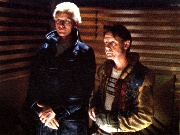 How
does Roy get to Tyrell so easily?
How
does Roy get to Tyrell so easily?
They've already tried the direct approach and the infiltration approach. Both failed. Roy and Pris manipulate J. F. Sebastian to get Roy in. Presumably the elevator doesn't detect multiple occupants. In an earlier script, Sebastian and Chew have the highest clearance. Even without this, Tyrell's arrogance lets the "milk and cookies" Sebastian come up.
Who wrote the "voiceover" in the original theatrical release version of BR?
Producers decided a voiceover was required to explain things. Darryl Ponicsan was first hired to write the VO, but his version was tossed out. Then a veteran TV screenwriter named Roland Kibbee was hired to write it and this is what was used. Why he was chosen is a mystery particularly as he was all but retired (his career spanning 1946-1980). Ford was still contracted and reluctantly came in to the studio to read the voiceover, but said he would only do it 10 times and that was it. According to Katie Haber (production executive), he read it the way he did on purpose, hoping it wouldn't then be used. In their interview for the BR documentary, Peoples and Fancher say that by the time the movie came out they had become friends and when they heard the voiceover, they were so worried about the possibility that the other had written it, they didn't make any negative comments about it for months afterwards. Note that a voiceover was actually included as an idea in earlier scripts and a few of the lines are reminiscent of that, so it isn't as totally tacked-on as the "happy ending".
Scott didn't like the way the excessive "Irving the Explainer"
voiceover turned out (and didn't want it added on anyway) so when
the pseudo-Director's Cut was made, this was one of the first things
to be excised. It will definitely not be reintroduced in the Special
Edition!

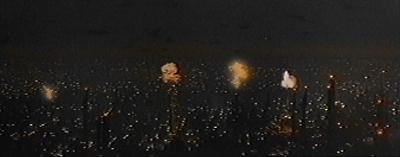
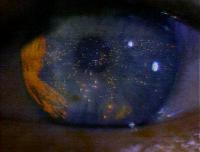 According
to the script, the eye is supposed to be Holden's. The actual eye
belongs to one of the assistants (Victoria Ewart) and was filmed
later. (This explains why it is the wrong colour for Holden.)
According
to the script, the eye is supposed to be Holden's. The actual eye
belongs to one of the assistants (Victoria Ewart) and was filmed
later. (This explains why it is the wrong colour for Holden.) 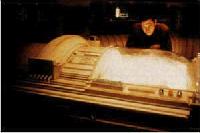 Yes,
he does. Although it's easy to miss for the casual viewer, Holden
survived, but is heavily wounded and needs to remain "plugged"
in, as Bryant calls it. In two deleted scenes, Deckard visits Holden
in a hospital.
Yes,
he does. Although it's easy to miss for the casual viewer, Holden
survived, but is heavily wounded and needs to remain "plugged"
in, as Bryant calls it. In two deleted scenes, Deckard visits Holden
in a hospital. Why
didn't Holden recognise Leon?
Why
didn't Holden recognise Leon?